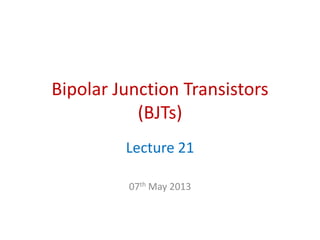Bipolar Junction Transistors (bj ts)
•Transferir como PPTX, PDF•
5 gostaram•4,988 visualizações
Denunciar
Compartilhar
Denunciar
Compartilhar

Recomendados
Recomendados
Mais conteúdo relacionado
Mais procurados
Mais procurados (20)
Electronics 1 : Chapter # 06 : Bipolar Junction Transistor

Electronics 1 : Chapter # 06 : Bipolar Junction Transistor
Destaque
Destaque (20)
Semelhante a Bipolar Junction Transistors (bj ts)
Semelhante a Bipolar Junction Transistors (bj ts) (20)
Unit 5-BEE Electronics for Engineering in Computer branch 2nd sem diploma by ...

Unit 5-BEE Electronics for Engineering in Computer branch 2nd sem diploma by ...
transistoranditsworkingprinciple-160427150207 (1) (1).pdf

transistoranditsworkingprinciple-160427150207 (1) (1).pdf
Digital_Logic_Design-ch_1for engineering students .pptx

Digital_Logic_Design-ch_1for engineering students .pptx
Último
Mehran University Newsletter is a Quarterly Publication from Public Relations OfficeMehran University Newsletter Vol-X, Issue-I, 2024

Mehran University Newsletter Vol-X, Issue-I, 2024Mehran University of Engineering & Technology, Jamshoro
Último (20)
Unit 3 Emotional Intelligence and Spiritual Intelligence.pdf

Unit 3 Emotional Intelligence and Spiritual Intelligence.pdf
Micro-Scholarship, What it is, How can it help me.pdf

Micro-Scholarship, What it is, How can it help me.pdf
This PowerPoint helps students to consider the concept of infinity.

This PowerPoint helps students to consider the concept of infinity.
Plant propagation: Sexual and Asexual propapagation.pptx

Plant propagation: Sexual and Asexual propapagation.pptx
Salient Features of India constitution especially power and functions

Salient Features of India constitution especially power and functions
Jual Obat Aborsi Hongkong ( Asli No.1 ) 085657271886 Obat Penggugur Kandungan...

Jual Obat Aborsi Hongkong ( Asli No.1 ) 085657271886 Obat Penggugur Kandungan...
Fostering Friendships - Enhancing Social Bonds in the Classroom

Fostering Friendships - Enhancing Social Bonds in the Classroom
UGC NET Paper 1 Mathematical Reasoning & Aptitude.pdf

UGC NET Paper 1 Mathematical Reasoning & Aptitude.pdf
General Principles of Intellectual Property: Concepts of Intellectual Proper...

General Principles of Intellectual Property: Concepts of Intellectual Proper...
Sensory_Experience_and_Emotional_Resonance_in_Gabriel_Okaras_The_Piano_and_Th...

Sensory_Experience_and_Emotional_Resonance_in_Gabriel_Okaras_The_Piano_and_Th...
Kodo Millet PPT made by Ghanshyam bairwa college of Agriculture kumher bhara...

Kodo Millet PPT made by Ghanshyam bairwa college of Agriculture kumher bhara...
HMCS Vancouver Pre-Deployment Brief - May 2024 (Web Version).pptx

HMCS Vancouver Pre-Deployment Brief - May 2024 (Web Version).pptx
Bipolar Junction Transistors (bj ts)
- 1. Bipolar Junction Transistors (BJTs) Lecture 21 07th May 2013
- 2. Brief Introduction of Transistor • Invented by a team of – Three men at Bell Laboratories in 1947. – Although it was not a BJT but it was the beginning of a technological revolution that is still continuing. – Almost all the electronic devices and systems today are an outgrowth of early developments in semiconductor transistors.
- 3. Two Basic Types • Bipolar Junction Transistor (BJT) • Field-Effect Transistor (FET) • Applications of BJTs – Used in two broad areas • As a linear amplifier to boost or amplify an electrical signal • As an electronic switch
- 4. Transistor Structure • BJT is constructed with three doped semiconductor regions separated by two pn junction. • The three regions are called emitter, base and collector. • One type consists of two n-regions separated by a p region (npn) and the other type consists of two p regions separated by an n region (pnp).
- 6. Junctions in BJTs • The pn junction joining the base region and the emitter region is called the base-emitter junction. • The pn junction joining the base region and the collector region is called the base-collector junction.
- 7. EBC - Terminals • A wire lead connects to each of the three regions. • • These leads are labeled E, B and C for Emitter, Base and Collector respectively. • The base region is lightly doped and very thin compared to the heavily doped emitter and the moderately doped collector regions. – (Assignment Qs, Why is it so?) – The term bipolar refers to the use of both holes and electrons as carriers in the transistor structure.
- 9. Transistor operation •The proper bias arrangement for both npn and pnp transistors for active operation as an amplifier is shown above. •In both cases the base-emitter (BE) junction is forward-biased and the base- collector (BC) junction is reverse-biased.
- 11. Working … • The forward bias from base to emitter narrows the BE depletion region, and the reverse bias from base to collector widens the BC depletion region, as depicted in figure. • The heavily doped n type emitter region is teeming with conduction-band (free) electrons that easily diffuse through the forward-biased BE junction into the p-type base region where they become minority carriers. • The base region is lightly doped and very thin so that it has a limited number of holes. Thus, only a small percentage of all the electrons flowing through the BE junction can combine with the available holes in the base. These relatively few recombined electrons flow out of the base lead as valence electrons causing small base electron current as shown above.
- 12. Working … • Once in this region electrons are pulled through the reverse biased BC junction by the electric field set up by the force of at- traction between the positive and negative ions. Actually you can think of the electrons as being pulled across the reverse-biased BC junction by the attraction of the collector supply voltage. • The electrons now move through the collector region, out through the collector lead, and into the positive terminal of the collector voltage source. This forms the collector electron current, as shown in figure above. The collector current is much larger than the base current. This is the reason transistors exhibit current gain.
- 14. Transistor Characteristics and Parameters
- 15. Contd…
